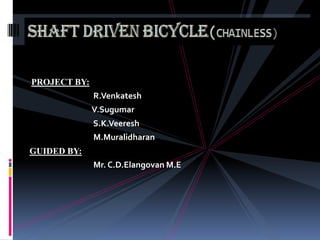Shaft driven bicycle(chainless)
- 1. PROJECT BY: R.Venkatesh V.Sugumar S.K.Veeresh M.Muralidharan GUIDED BY: Mr. C.D.Elangovan M.E
- 2. ABSTRACT: ’āś A shaft-driven bicycle is a bicycle that uses a drive shaft instead of a chain to transmit power from the pedals to the wheel. Shaft drives were introduced over a century ago, but were mostly supplanted by chain-driven bicycles due to the gear ranges possible with sprockets and derailleur. Recently, due to advancements in internal gear technology, a small number of modern shaft-driven bicycles have been introduced. ’āś Shaft-driven bikes have a be where a conventional bike would have its chain ring. This meshes with another bevel gear mounted on the drive shaft. The Bevel gears are the most efficient way of turning drives 90 degrees as compared to worm gears or crossed helical gear. ’āś The shaft drive only needs periodic lubrication using a grease gun to keep the gears running quiet and smooth. This ŌĆ£chainlessŌĆØ drive system provides smooth, quite and efficient transfer of energy from the pedals to the rear wheel. It is attractive in look compare with chain driven bicycle. It replaces the traditional method.
- 3. Shaft driven bicycle: CHAIN LESS
- 4. INTRODUCTION: ’é¦ The first shaft drives for cycles appear to have been invented independently in 1890 in the United States and England. ’é¦ If bevel-wheels could be accurately and cheaply cut by machinery, it is possible that gears of this description might supplant, to a great extent, the chain-drive gear; but the fact that the teeth of the bevel-wheels cannot be accurately milled is a serious obstacle to their practical success
- 5. SHAFT DRIVEN SYSTEM: ’é¦ The shaft is connected between the pair of spiral bevel gears. ’é¦ The main application of the spiral bevel gear is in a vehicle differential, where the direction of drive from the drive shaft must be turned 90 degrees to drive the wheels. ’é¦ The helical design produces less vibration and noise than conventional straight-cut or spur-cut gear with straight teeth.
- 6. Components: ’é¦ Bicycle ’é¦ Shaft ’é¦ Bevel gears
- 7. Shaft Drive Versus Chain ’é¦ High durability ’é¦ Low durability ’é¦ Less noise ’é¦ Noisy ’é¦ Safe no chain bite ’é¦ Tear and soil clothing ’é¦ 90%+ efficient and cut hands (consistently with ’é¦ 75% - 95% efficient minimal maintenance) (varies depending on ’é¦ Easy - no grease or condition and upkeep) external components to ’é¦ Dirty and greasy chain; disturb or damage sharp sprocket teeth; delicate components susceptible to damage ’é¦
- 8. Shaft Drive Versus Chain
- 9. ADVANTAGES ’é¦ Smoother ride: ’é¦ Easier to transport ’é¦ Lower cost of ownership ’é¦ Cleaner
- 10. APPLICATION: ’é¦ Racing ’é¦ Off ŌĆōroad riding ’é¦ cycling
- 11. THANKING YOU










